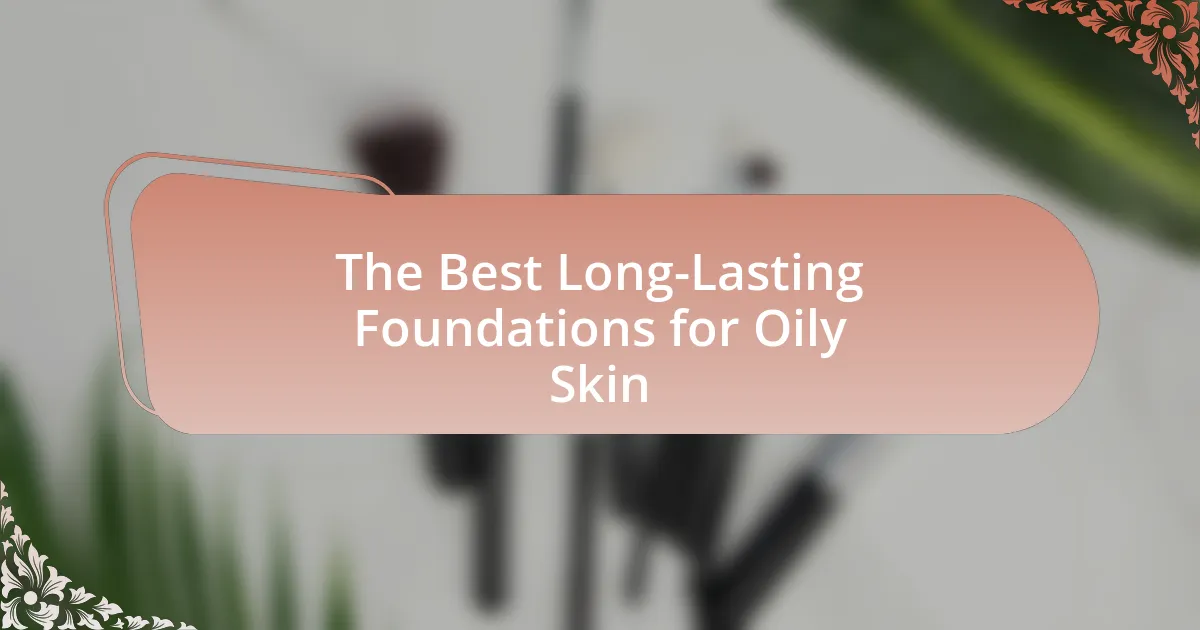The article focuses on the best long-lasting foundations specifically formulated for oily skin, highlighting their unique ingredients and benefits. It discusses how these foundations differ from regular options, emphasizing the importance of oil control, transfer resistance, and a matte finish. Key ingredients such as silicones, oil-absorbing powders, and film-forming agents are examined for their role in enhancing foundation longevity. The article also reviews popular products like Estée Lauder Double Wear and Fenty Beauty Pro Filt’r, while providing guidance on selecting the right shade, undertone, and application techniques to achieve a flawless look. Additionally, it addresses common challenges faced by individuals with oily skin and offers tips for maintaining makeup throughout the day.

What are Long-Lasting Foundations for Oily Skin?
Long-lasting foundations for oily skin are specifically formulated to control excess oil and provide a matte finish throughout the day. These foundations often contain oil-absorbing ingredients such as silica or kaolin clay, which help to minimize shine and prevent breakouts. Popular options include Estée Lauder Double Wear Stay-in-Place Makeup, which offers up to 24-hour wear and is known for its transfer-resistant formula, and Fenty Beauty Pro Filt’r Soft Matte Longwear Foundation, praised for its wide shade range and long-lasting matte finish. Both products have been tested and reviewed extensively, confirming their effectiveness for individuals with oily skin.
How do long-lasting foundations differ from regular foundations?
Long-lasting foundations differ from regular foundations primarily in their formulation and wear time, designed to withstand oil and sweat for extended periods. Long-lasting foundations typically contain oil-absorbing ingredients and are often water-resistant, which helps them maintain coverage throughout the day, especially for oily skin types. In contrast, regular foundations may not have these properties, leading to quicker breakdown and fading, particularly in humid or active environments. Studies indicate that long-lasting foundations can provide up to 16 hours of wear, while regular foundations may last significantly less, often around 6 to 8 hours, making them less suitable for individuals with oily skin.
What ingredients contribute to the longevity of foundations?
Ingredients that contribute to the longevity of foundations include silicones, oil-absorbing powders, and film-forming agents. Silicones, such as dimethicone, create a smooth barrier that enhances wear time and prevents fading. Oil-absorbing powders, like talc or silica, help control shine and maintain a matte finish, which is crucial for oily skin. Film-forming agents, such as acrylates, provide a long-lasting hold by creating a flexible layer that adheres to the skin, ensuring the foundation stays in place throughout the day. These ingredients are commonly found in long-lasting foundations specifically formulated for oily skin, enhancing their durability and performance.
How do these ingredients specifically benefit oily skin?
Ingredients that benefit oily skin typically include oil-absorbing agents, mattifying compounds, and non-comedogenic formulations. These components help control excess sebum production, reduce shine, and prevent clogged pores. For example, ingredients like salicylic acid exfoliate and unclog pores, while kaolin clay absorbs oil and minimizes shine. Additionally, formulations containing silica can create a smooth, matte finish that lasts throughout the day. Studies have shown that products with these ingredients can significantly improve skin texture and reduce the appearance of oiliness, making them ideal for individuals with oily skin.
Why is it important to choose the right foundation for oily skin?
Choosing the right foundation for oily skin is crucial because it helps control excess oil and shine while providing a smooth, long-lasting finish. Foundations specifically formulated for oily skin often contain oil-absorbing ingredients, such as silica or clay, which minimize shine and prevent makeup from sliding off throughout the day. Additionally, using the appropriate foundation can reduce the likelihood of clogged pores and breakouts, as many products designed for oily skin are non-comedogenic. This targeted approach ensures that the makeup not only looks good but also supports skin health, making it essential for individuals with oily skin to select the right product.
What challenges do individuals with oily skin face when selecting foundations?
Individuals with oily skin face several challenges when selecting foundations, primarily due to excess sebum production. This excess oil can lead to foundations sliding off the skin, causing uneven application and requiring frequent touch-ups. Additionally, many foundations may exacerbate oiliness or contribute to breakouts if they contain heavy or comedogenic ingredients. According to a study published in the Journal of Cosmetic Dermatology, formulations that are oil-free and non-comedogenic are recommended for oily skin types to minimize these issues. Furthermore, individuals often struggle to find foundations that provide adequate mattifying effects without appearing cakey or heavy, which can further complicate their selection process.
How can the right foundation improve makeup longevity for oily skin?
The right foundation can significantly improve makeup longevity for oily skin by providing a matte finish and controlling excess oil production. Foundations specifically formulated for oily skin often contain oil-absorbing ingredients, such as silica or clay, which help to reduce shine and prevent makeup from breaking down throughout the day. Studies indicate that using a foundation with a long-wear formula can extend the wear time of makeup by up to 12 hours, making it ideal for individuals with oily skin. Additionally, foundations with a lightweight texture can prevent the clogging of pores, which is crucial for maintaining a fresh appearance and ensuring that makeup adheres better to the skin.

What Features Should You Look for in Long-Lasting Foundations?
Long-lasting foundations should have oil control, transfer resistance, and a matte finish. Oil control is essential for preventing shine and maintaining a fresh appearance throughout the day, especially for oily skin types. Transfer resistance ensures that the foundation stays in place without smudging or fading, which is crucial for long wear. A matte finish helps to absorb excess oil and reduce the appearance of pores, contributing to a smooth complexion. These features are supported by consumer reviews and dermatological studies that highlight the effectiveness of specific formulations designed for oily skin, such as those containing silica or clay, which are known to absorb oil and provide a long-lasting matte effect.
What types of formulas are best for oily skin?
Matte formulas are best for oily skin. These foundations typically contain oil-absorbing ingredients like silica or clay, which help control shine and provide a smooth finish. Additionally, water-based or gel-based foundations are effective as they are lightweight and reduce the risk of clogging pores. According to a study published in the Journal of Cosmetic Dermatology, matte foundations significantly reduce sebum production and improve the overall appearance of oily skin.
How do matte vs. dewy finishes affect oily skin?
Matte finishes are generally more suitable for oily skin as they help absorb excess oil and reduce shine, leading to a more controlled appearance throughout the day. In contrast, dewy finishes can exacerbate oiliness by adding a shiny layer, which may lead to a greasy look and require more frequent touch-ups. Studies indicate that matte formulations often contain oil-absorbing ingredients like silica or clay, which effectively minimize shine, while dewy products typically include hydrating components that can contribute to an oily appearance.
What role do oil-free and non-comedogenic formulas play?
Oil-free and non-comedogenic formulas play a crucial role in preventing clogged pores and reducing acne breakouts for individuals with oily skin. These formulations are specifically designed to avoid ingredients that can exacerbate oiliness or lead to the formation of comedones, which are the primary contributors to acne. Research indicates that products labeled as non-comedogenic have been tested to ensure they do not block pores, making them suitable for those prone to acne. By using oil-free and non-comedogenic foundations, individuals with oily skin can achieve a matte finish while maintaining skin health and minimizing the risk of breakouts.
How can you determine the right shade and undertone?
To determine the right shade and undertone, assess your skin’s natural color in natural light. The primary method involves identifying whether your undertone is warm, cool, or neutral by examining the veins on your wrist; blue veins indicate cool undertones, green veins suggest warm undertones, and a mix of both points to neutral undertones. Additionally, testing foundation shades on your jawline can help find a match that seamlessly blends with your skin. According to a study published in the Journal of Cosmetic Dermatology, understanding undertones significantly enhances the accuracy of foundation selection, leading to better overall satisfaction with cosmetic products.
What tools can help in finding the perfect foundation shade?
Tools that can help in finding the perfect foundation shade include color-matching apps, in-store testers, and professional color matching services. Color-matching apps, such as Sephora’s Virtual Artist, utilize augmented reality to allow users to see how different shades look on their skin in real-time. In-store testers provide an opportunity to apply foundation directly on the skin, ensuring a better match under natural lighting. Professional color matching services, often available at beauty counters, involve trained staff who assess skin tone and undertones to recommend the most suitable shades. These tools enhance the accuracy of shade selection, leading to a more satisfactory foundation choice.
Why is understanding undertones crucial for oily skin foundations?
Understanding undertones is crucial for oily skin foundations because the right undertone ensures a natural-looking finish that complements the skin’s unique hue. Oily skin often reflects light differently, which can make mismatched foundation shades appear more pronounced. For instance, foundations with warm undertones can enhance the natural warmth of oily skin, while cool undertones can counteract redness. Research indicates that selecting the correct undertone can improve the overall appearance and longevity of makeup, particularly for oily skin types, which are prone to shine and uneven texture.

What are the Top Long-Lasting Foundations for Oily Skin?
The top long-lasting foundations for oily skin include Fenty Beauty Pro Filt’r Soft Matte Longwear Foundation, Estée Lauder Double Wear Stay-in-Place Makeup, and Maybelline Fit Me Matte + Poreless Foundation. These foundations are specifically formulated to control oil and shine while providing a matte finish that lasts throughout the day. For instance, Fenty Beauty’s foundation is known for its extensive shade range and oil-absorbing properties, making it suitable for various skin tones and types. Estée Lauder’s Double Wear is renowned for its 24-hour wear and resistance to sweat and humidity, which is crucial for oily skin. Maybelline’s Fit Me offers a lightweight feel while effectively minimizing the appearance of pores, making it a popular choice among those with oily skin.
Which brands are known for their long-lasting foundations?
Brands known for their long-lasting foundations include Estée Lauder, Fenty Beauty, and Maybelline. Estée Lauder’s Double Wear Stay-in-Place Makeup is renowned for its 24-hour wear and oil control, making it a favorite among those with oily skin. Fenty Beauty’s Pro Filt’r Soft Matte Longwear Foundation offers a wide shade range and is designed to withstand humidity and sweat. Maybelline’s Super Stay Full Coverage Foundation is also recognized for its longevity, providing up to 24 hours of wear while resisting transfer. These brands consistently receive positive reviews for their ability to maintain coverage throughout the day, particularly for oily skin types.
What are the standout products from these brands?
The standout products for oily skin from leading brands include Estée Lauder Double Wear Stay-in-Place Makeup, which is renowned for its 24-hour wear and oil control, and Fenty Beauty Pro Filt’r Soft Matte Longwear Foundation, praised for its extensive shade range and matte finish. Additionally, Maybelline Fit Me Matte + Poreless Foundation is recognized for its affordability and effective oil absorption. These products are specifically formulated to provide long-lasting coverage while managing excess oil, making them ideal for individuals with oily skin.
How do user reviews and ratings influence product selection?
User reviews and ratings significantly influence product selection by providing potential buyers with insights into the experiences of previous customers. Research indicates that 79% of consumers trust online reviews as much as personal recommendations, highlighting their impact on purchasing decisions. Positive reviews can enhance a product’s credibility and desirability, while negative ratings can deter potential buyers, leading them to choose alternatives. In the context of long-lasting foundations for oily skin, users often rely on reviews to assess factors such as oil control, wear time, and overall satisfaction, making these evaluations crucial in guiding their choices.
What are the price ranges for effective long-lasting foundations?
Effective long-lasting foundations typically range in price from $10 to $70. Drugstore brands often offer effective options starting around $10 to $20, while high-end brands can range from $30 to $70. For instance, popular long-lasting foundations like Maybelline Fit Me Matte + Poreless are priced around $10, while high-end options like Estée Lauder Double Wear Foundation can cost approximately $45. This price variation reflects differences in formulation, brand reputation, and additional skincare benefits.
How do budget options compare to high-end foundations?
Budget options typically offer less pigmentation, shorter wear time, and fewer skin-benefiting ingredients compared to high-end foundations. High-end foundations often utilize advanced formulations, providing better coverage, longer-lasting wear, and additional skincare benefits such as hydration or oil control, which are particularly important for oily skin. For instance, a study published in the Journal of Cosmetic Dermatology found that high-end foundations often contain higher concentrations of active ingredients, leading to improved skin texture and appearance over time.
What value do premium foundations offer for oily skin?
Premium foundations offer superior oil control and long-lasting wear for oily skin. These products often contain advanced formulations with mattifying agents, such as silica or kaolin clay, which absorb excess oil and reduce shine throughout the day. Additionally, premium foundations frequently include high-quality pigments that provide better coverage and a more natural finish, minimizing the appearance of pores and imperfections. Research indicates that foundations designed for oily skin can significantly improve skin texture and longevity, with many lasting up to 12 hours without touch-ups.

How Can You Make Your Foundation Last Longer on Oily Skin?
To make your foundation last longer on oily skin, start by using a mattifying primer, which helps control excess oil and creates a smooth base for foundation application. Studies show that primers can significantly enhance foundation longevity by reducing shine and improving adherence to the skin. Additionally, opt for oil-free, long-wear foundations specifically formulated for oily skin, as they contain ingredients that absorb oil and resist fading. Setting your foundation with a translucent powder can further lock it in place, as it minimizes shine and provides a matte finish. Regular touch-ups with oil-absorbing sheets can also help maintain a fresh look throughout the day.
What application techniques enhance foundation longevity?
To enhance foundation longevity, techniques such as using a primer, setting powder, and a setting spray are essential. Primers create a smooth base and help the foundation adhere better to the skin, while setting powders absorb excess oil and lock the foundation in place. Additionally, applying a setting spray after makeup application can provide a protective layer that further extends wear time. Studies indicate that using these techniques can significantly improve the durability of makeup, particularly for oily skin types, by reducing shine and preventing makeup breakdown throughout the day.
How does primer affect the wear of foundation on oily skin?
Primer significantly enhances the wear of foundation on oily skin by creating a smooth, oil-controlling base that helps to minimize shine and prolong the foundation’s longevity. Specifically, primers formulated for oily skin often contain mattifying ingredients, such as silica or clay, which absorb excess oil and prevent the foundation from breaking down throughout the day. Research indicates that using a primer can increase the wear time of foundation by several hours, making it a crucial step for individuals with oily skin seeking a long-lasting makeup look.
What setting products can be used to lock in foundation?
Setting sprays and powders are effective products used to lock in foundation. Setting sprays, such as Urban Decay All Nighter or MAC Prep + Prime Fix+, create a barrier that helps maintain makeup longevity by preventing smudging and fading. Setting powders, like Laura Mercier Translucent Loose Setting Powder or RCMA No Color Powder, absorb excess oil and provide a matte finish, ensuring that foundation stays in place throughout the day. These products are widely recognized in the beauty industry for their ability to enhance the durability of makeup, particularly for oily skin types.
What common mistakes should be avoided when applying foundation?
Common mistakes to avoid when applying foundation include using the wrong shade, applying too much product, neglecting skin preparation, and skipping blending. Using a foundation shade that does not match the skin tone can lead to an unnatural appearance, while applying excessive product can result in a cakey finish. Proper skin preparation, such as moisturizing and priming, is essential for a smooth application, as it helps the foundation adhere better and last longer. Additionally, failing to blend foundation evenly can create harsh lines and an uneven texture. These mistakes can significantly impact the overall look and longevity of foundation, especially for oily skin types.
How can over-application affect the appearance of foundation?
Over-application of foundation can lead to a cakey and unnatural appearance on the skin. When too much product is used, it can settle into fine lines and pores, emphasizing imperfections rather than providing a smooth finish. Additionally, excessive layers can cause the foundation to oxidize more quickly, resulting in an uneven skin tone. Studies indicate that the optimal amount of foundation for a natural look is typically a thin layer, which allows the skin to breathe and reduces the risk of a heavy appearance.
What are the best practices for touch-ups throughout the day?
The best practices for touch-ups throughout the day include using blotting papers, applying a lightweight powder, and utilizing a setting spray. Blotting papers effectively absorb excess oil without disturbing makeup, making them ideal for quick touch-ups. Applying a lightweight powder helps to mattify the skin and reduce shine, while a setting spray can lock in makeup and refresh the look. These methods are particularly beneficial for individuals with oily skin, as they help maintain a polished appearance without adding heavy layers of product.
What tips can help maintain a flawless look with long-lasting foundations?
To maintain a flawless look with long-lasting foundations, start with a proper skincare routine that includes cleansing, exfoliating, and moisturizing to create a smooth base. Using a mattifying primer specifically designed for oily skin can help control shine and enhance foundation longevity. Additionally, applying the foundation with a damp makeup sponge or brush ensures even coverage and better adherence to the skin. Setting the foundation with a translucent powder can further lock it in place and reduce oiliness throughout the day. Regular touch-ups with blotting papers can help manage excess oil without disturbing the foundation. These practices are supported by dermatological advice emphasizing the importance of skin preparation and product selection for optimal makeup performance.


